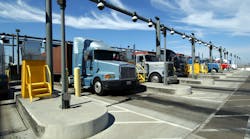The economy in 2015 through 2016 should see output grow 3.0% and monthly employment will change upward by 210,000 to signal a “new new normal.” That’s the key takeaway of the baseline economic forecast presented during the latest FTR webinar on assessing freight risks by economist Bill Witte, senior consultant with the research and analysis firm.
Looking back to provide context, Witte said that by comparison the period from 2011 to mid-2013 was the “new (sub) normal,” thanks to an average output growth of just 2.0% and an average monthly employment change of 175,000. After that, over the past five quarters, things picked up with output growth averaging 2.5% and employment change 220,000, he explained.
“In four of the five last quarters, GDP growth was over 3% and in two of those, it rose above 4%,” Witte elaborated. “Underscoring that growth were dramatic improvements in most areas of the economy.”
Returning to his outlook, he said that during 2015-2016, “we’ll see close to 3% output growth on average and an average monthly employment change of 210,000.”
Witt added that in light of his projection of economic activity over the next two years, the question remains whether or not “rapid growth will finally occur” to benefit the freight segment.
Providing his take on where the economy may be headed, economist and FTR senior consultant Noël Perry advised that “I am optimistic about 2015 but pessimistic beyond then.
“If the economy produces an average growth rate of 3 to 3.5% for a year and even if that average does not change,” he continued, “the individual quarters will vary from higher to lower. This economic upturn has been string in terms of [the effect of] transportation multipliers on GDP.
In fact, Perry noted that “in this upturn, transportation has been growing faster than GDP. So, we could have higher quarters for both trucking and rail in 2015. But these upsides may not last a year— but perhaps [they will extend over] two quarters.”
Perry also contended that in forecasting the road ahead, “the real issue is that transportation [including all modes] tends to react quickly to changes in GDP. So, we could get an upward burst [of economic activity] or a recession.”
For 2015, he pegged the likelihood of seeing “a big upside burst” at 15% and that of a “downside occurring” at 10%. All in all, Perry added, there “should be a continuation [in 2015] of the pretty nice recovery that transportation has seen this year.”
FTR has separately reported that its Trucking Conditions Index (TCI) for September scored a “positive reading of 9.07, reflecting “strong underlying market trends.”
The firm noted that the TCI has “moved up in the last couple of months, due to increased rate gains, and will remain in very positive but stable territory for the foreseeable future.”
FTR expects little change in the TCI “unless and until there is a change in the economy or increased regulatory drag on capacity. Capacity utilization currently stands within 100 basis points of its all-time record and is at the breakpoint between manageable tightness and crisis.”
Regarding the TCI uptick, Jonathan Starks, FTR's director of transportation analysis, said that "Spot market activity and rates have been easing, but this is to be expected at this time of year. Rates are still well above year-ago levels and will stay that way until we lap winter conditions in January and February. The contract market is lagging on rate growth, but we still see a concerted upward shift over the last year. The combination of HOS changes in 2013 with weather events in 2014 was enough to move market conditions in truckers favor.
“Contract negotiations will take place during the winter slow season-- we will see how much market clout the fleets are able to use,” he continued. “The real results will come later in the year. Successful shippers will be able to secure capacity and limit cost inflation by working with their carrier base rather than focusing on negotiating strength."



